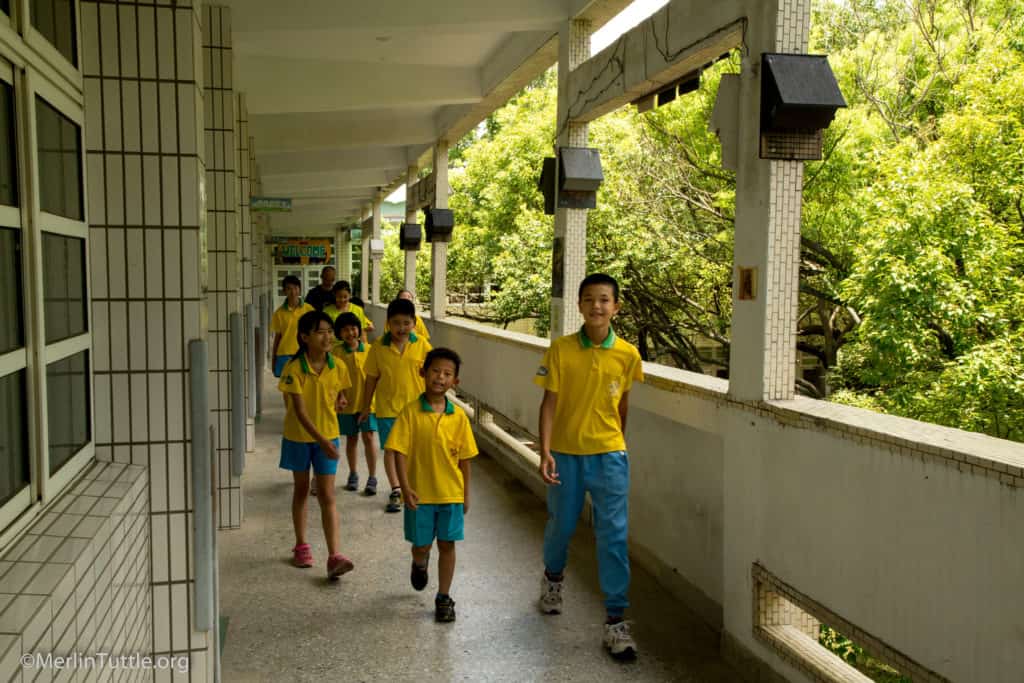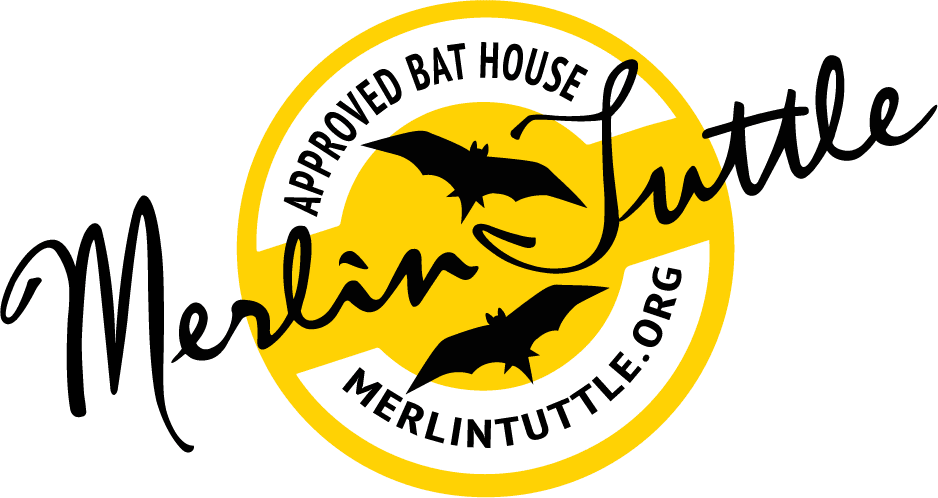Tracking the Impacts of WNS at Wisconsin’s Stonefield Historic Site
“Just like the old days, eh Heather?” Kent softly clicks his tally counter as he sits in his folding chair on the other side of
Bat houses are outstanding tools for education. When I introduced them to Americans in 1982, my primary objective was to help people overcome fear and accept bats as valuable neighbors. That goal has been vastly exceeded. Today, hundreds of thousands of American bats live in a wide variety of bat houses.
Individuals who have carefully tested local bat preferences, and adapted accordingly, are reporting close to 90 percent occupancy. Nevertheless, there is still much to be learned. And that is why we’re initiating new collaborations.
Late last month, local member, Debbie Zent, founder of Austin Batworks, reported an impressive event. Her three-chamber nursery house had been caulked, sealed, and painted inside and out, and was mounted high on a streamside ranch building—a nearly perfect combination. But to find it overflowing with occupants just days later was surprising.
Was this extraordinary success due to house or location quality, or were these bats simply desperate?
We are now working with Debbie to test the latest innovations in bat-rich areas, especially where previous attempts have failed. Additionally, we recently collaborated with Tom and Laura Finn, founders of Fly By Night, Inc., to test three of their Deluxe Bat Condos that have peak-season capacity to shelter up to 1,000 bats each. Hundreds have been installed in Florida with 90 percent occupancy. Ours were mounted on poles near rivers. Additionally, Tom helped us mount three small houses on nearby buildings.
Tom demonstrating how to use a rope to lift a bat house after having climbed a ladder. This BatBnB two-chamber house has been altered with three-quarter-inch thick furring strips to provide extra roosting space between the house and building. This adds an additional roosting chamber at little cost (above, left). During installation, Tom braces the house on his ladder. This house will be shielded from rain but exposed to morning sun (above, right).
On a broader scale, Jay Gaderre, of WHITEHORSE, has agreed to help test a small bat house design that has proven more than 90 percent successful in Taiwan. Jay will be shipping samples for testing in five U.S. states.

Why so much new testing? Haven’t we already learned all we need to know about bat house basics? Yes, between 1988 and 2004 we did learn a great deal through the North American Bat House Research Project, led by Mark and Selena Kiser and myself, relying on invaluable reports from thousands of volunteer participants.
Virtually all kinds of bat houses were at least occasionally successful. But the best-used houses were:
Failures were strongly associated with:
Initial results were mixed. Some users uniformly failed while others with similar houses were dramatically successful. As we’ve gradually discovered why, occupancy success has improved.
Temperature was identified as a key determinant. Bat houses could be too hot or too cool, or could simply fluctuate too much. For example, in coastal areas of the Northwest, bats readily occupied houses mounted on poles but rejected them east of the Cascade Mountains. Day-to-night temperature fluctuated too much in arid areas. This can be solved only by using extra-large houses or by mounting them on buildings which serve as heat-sinks that dampen day-to-night temperature fluctuations.
Except in areas of extreme day-to-night changes, pairs of houses mounted back-to-back on poles in full sun, one facing southeast, the other northwest, are increasingly favored by America’s most experienced bat house users. Testing can pay big dividends.
In Florida, Ernie Stevens hung a bat house from a tree limb and attracted a nursery colony of 124 apparently desperate evening bats. When I convinced him to try mounting a pair of houses back-to-back on a pole in full sun, his original colony moved to the house facing northwest and expanded to over 300. These were joined by free-tailed bats in the warmer southeast-facing house. His resulting mixed colony included 800 bats!
In Louisiana, Bill Halloway began by mounting two houses on pine trees. No bats were attracted, so he moved them to a pole, mounted back-to-back. Bats promptly began moving in. Encouraged, he added another pair of larger houses on a pole, one black and one white, and ended up with a mixed nursery colony of 800 free-tailed and big brown bats, apparently due to a greater range of temperature options.
Much can be learned by simply watching bat house occupants on warm versus cool days.
In Pennsylvania, Lisa Williams and Cal Butchkoski noticed that their little brown bats moved up on cool days, down on warm, literally hanging their heads out on extra hot days. By adding ventilation slots, they were able to protect their bats from overheating, even in sun-exposed, black houses on the hottest days. Vents are now standard in all but the coolest climates.
As a result of such reported discoveries, the Kisers and I were able to publish the Bat House Builder’s Handbook in 1993. Over the subsequent 27 years discoveries have continued. Recently, Dani Cordani and I have been interviewing America’s most experienced bat house users in a wide variety of habitats and climates, each with decades of experience with hundreds of bat houses.
Based on their experiences, it’s clear there is still more to learn. We’re working on an updated resource that will:
If you’ve made a potentially important discovery, it’s not too late to share it with us at bathouses@merlintuttle.org. If you’d like to support these endeavors, please donate here and/or join MTBC as a sustaining member.
To better protect both bats and bat house consumers, MTBC is also offering our seal of approval to vendors whose houses meet our strict standards for construction and advice. Our resource, Selecting a Quality Bat House, provides guidance and a list of certified vendors. To apply for certification, contact bathouses@merlintuttle.org.

Love our content? Support us by sharing it!
“Just like the old days, eh Heather?” Kent softly clicks his tally counter as he sits in his folding chair on the other side of
It’s summertime (in the Northern Hemisphere) and the evening skies are alive with activity. As the sun sets, bugs are flying around and bats are
How hot is too hot? When it comes to bats and their ideal roosting temperatures, striking the right balance is crucial. We know that bats
Thirty-six attendees from eight states attended our second annual “Join the Nightlife” workshop, a unique collaboration organized by Merlin Tuttle’s Bat Conservation (MTBC), in partnership
2024 © Merlin Tuttle’s Bat Conservation. All rights reserved.
Madelline Mathis has a degree in environmental studies from Rollins College and a passion for wildlife conservation. She is an outstanding nature photographer who has worked extensively with Merlin and other MTBC staff studying and photographing bats in Mozambique, Cuba, Costa Rica, and Texas. Following college graduation, she was employed as an environmental specialist for the Florida Department of Environmental Protection. She subsequently founded the Florida chapter of the International DarkSky Association and currently serves on the board of DarkSky Texas. She also serves on the board of Houston Wilderness and was appointed to the Austin Water Resource Community Planning Task Force.
Michael Lazari Karapetian has over twenty years of investment management experience. He has a degree in business management, is a certified NBA agent, and gained early experience as a money manager for the Bank of America where he established model portfolios for high-net-worth clients. In 2003 he founded Lazari Capital Management, Inc. and Lazari Asset Management, Inc. He is President and CIO of both and manages over a half a billion in assets. In his personal time he champions philanthropic causes. He serves on the board of Moravian College and has a strong affinity for wildlife, both funding and volunteering on behalf of endangered species.